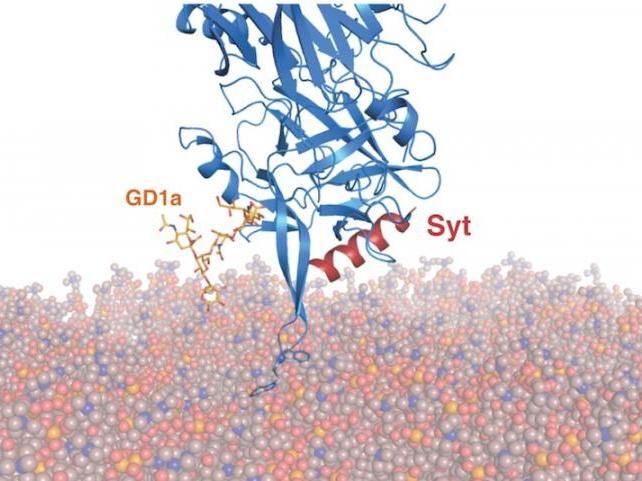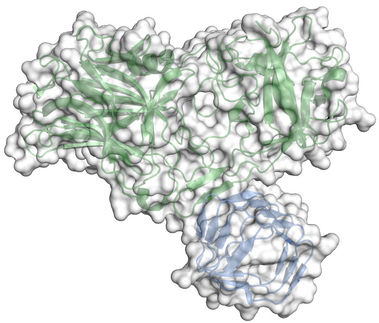Building a better botox
Small engineering tweaks to botulinum toxin B could make it more effective and longer-lasting with fewer side effects
Advertisement
Botulinum toxins -- a.k.a. Botox -- have a variety of uses in medicine: to treat muscle overactivity in overactive bladder, to correct misalignment of the eyes in strabismus, for neck spasms in cervical dystonia, and more. Two botulinum toxins, types A and B, are FDA-approved and widely used. Although they are safe and effective, the toxins can drift away from the site of injection, reducing efficacy and causing side effects.

A genetically enhanced botulinum toxin B attaching to the nerve-cell surface via an engineered lipid-binding loop (blue), together with binding to two receptors (GD1a and hSyt1).
Yin L; et al. PLoS Biology 2020 Mar 17
New research at Boston Children's Hospital finds that some small engineering tweaks to botox B could make it more effective and longer-lasting with fewer side effects.
A third way for botox B to bind to nerves
Botox works by attaching to nerves near their junction with muscles, using two cell receptors. Once docked, it blocks release of neurotransmitter, paralyzing the muscle.
Min Dong, PhD, at Boston Children's, with lab members Linxiang Yin, PhD, Sicai Zhang, PhD, and Jie Zhang, PhD, had been looking for ways to get botox B to bind to nerve cells more strongly, to keep it in place and avoid side effects. In another member of the botox family, type DC, they identified a potential third means of attachment: a lipid-binding loop capable of penetrating lipid membranes. Through structural modeling studies, they discovered that when particular amino acids are at the tip of the loop, the toxin can indeed use the loop to attach to the nerve-cell surface, in addition to binding to toxin receptors.
They further found that although botox B contains this same lipid-binding loop, it lacks these key amino acids at its tip. So Dong and colleagues added them in through genetic engineering.
As hoped, the introduced changes enhanced the toxin's ability to bind to nerve cells. In a mouse model, the engineered toxin was absorbed by local neurons around the injection site more efficiently than the FDA-approved form of botox B, with less diffusion away from the injection site. This led to more effective local muscle paralysis, longer-lasting local paralysis, and reduced systemic toxicity.
"Based on our mechanistic insight, we created an improved toxin that showed higher therapeutic efficacy, better safety range, and much longer duration," says Dong. "The type A toxin does not have the lipid-binding loop, so we are still working on engineering this lipid-binding capability into type A."

























































